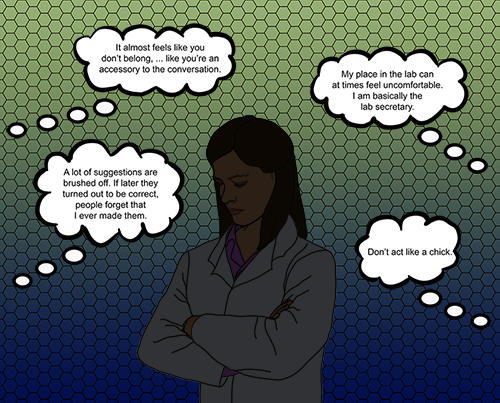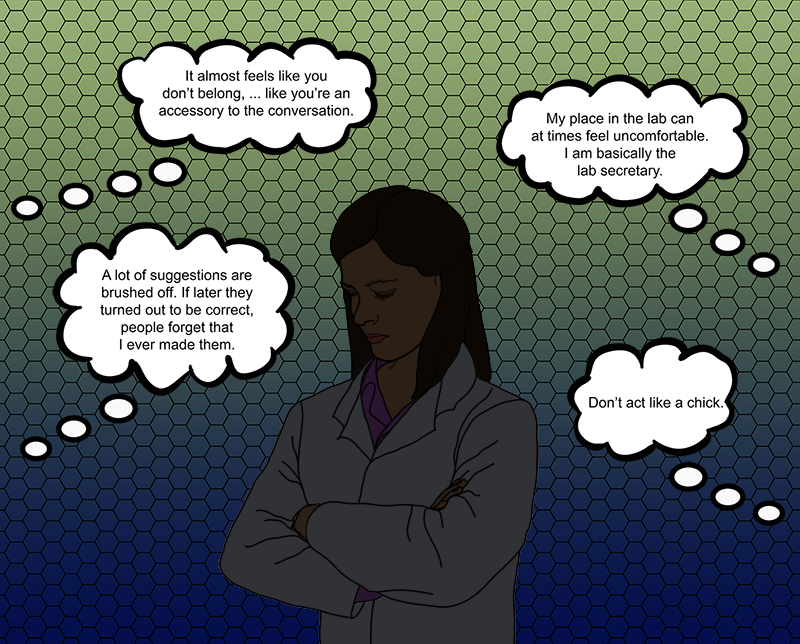How Stereotypes Impact Women in Physics
We believe science is rational and unbiased, but is the same true for scientists themselves? In recent years, researchers have begun to question how the culture of the scientific community influences the experiences of those who join it. In a special collection of Physical Review Physics Education Research focused on gender studies, two papers spotlight the ways in which the culture of experimental physics can create an unequal workplace that constrains women’s choices, behavior, and training. Ramón Barthelemy of the University of Jyväskylä, Finland, and colleagues [1] and Allison Gonsalves of McGill University, Canada, and co-workers [2] interviewed students and faculty members at physics labs in several countries, identifying many ways in which stereotypes—both implicit and explicit—affect professional interactions and impact the careers of women.
These two articles fit nicely within a larger body of social science research on gender stereotyping. Gender stereotypes are widely shared assumptions about the traits, behaviors, and roles of women and men. They typically include the assumption that men and women are very different from one another, with each group being “naturally good” at some things and “naturally bad” at others. In the absence of information, gender stereotypes can lead people to make (often false) inferences about the abilities and skills of individual men or women. For example, scientists and laypersons alike often assume that successful scientists, mathematicians, and engineers are men, and they express doubt about women’s skills in these professions [3].
Stereotypes can be explicit (openly expressed) or implicit (“leaked out” unconsciously in spontaneous speech or body language). The studies by Barthelemy et al. and by Gonsalves et al. illustrate that explicit and implicit stereotypes, equating “real physicists” with men, are prevalent within experimental physics communities in North America and Western Europe [1, 2]. Barthelemy et al. conducted in-depth interviews with 21 women in the advanced stages of Ph.D. programs in experimental physics, astrophysics, or astronomy at major universities in the U.S. They then performed a thematic analysis on the interview transcripts, which involves identifying recurring themes in conversations. Gonsalves et al. carried out case studies in three different countries: a physics department at a university in Sweden; a physics department at a university in Canada; and a plasma physics laboratory at a university in the U.S. All three case studies included interviews; two also included observations of professors, staff scientists, and Ph.D. students as they conducted experiments, participated in seminars, worked in their offices, attended meetings, and interacted with each other in the lab. The U.S. case study also involved a visit to a plasma physics conference, at which eight physicists were interviewed. While Barthelemy et al. only interviewed female graduate students, Gonsalves et al. interviewed both men and women, as well as students and faculty.
Both articles recount stories—from students and faculty—of male students making explicit sexist jokes or comments in the lab. Gonsalves et al., for example, observed one lab in which male graduate students censured their male peers for low-quality work by saying, “Don’t act like a chick”—a derogatory statement equating poor performance with being a woman. Barthelemy et al. found more subtle or implicit stereotypes in the use of gendered language, with expressions such as “lady physics,” which conveys doubt about women as real physicists. These observations are consistent with published research showing that implicit stereotypes are often embedded in the pronouns people use to describe certain professions, such as: “We recognize a talented scientist when we see him” [4]. Implicit stereotypes also surfaced in the study by Barthelemy et al. For example, the authors found that many male students and faculty ignored women’s ideas and feedback but recognized the exact same ideas when voiced later by men, or they treated women as though they were invisible in professional conversations [1].
These gender stereotypes have a host of negative effects on women in physics. For one, they act as an extra mental burden, increasing the worry women have about confirming negative expectations. This can lead to a phenomenon called stereotype threat [5], in which women underperform on difficult exams relative to their actual potential: when the exact same tests are given in settings that reduce this threat, women perform as well as men [6]. Gender stereotypes can also constrain a woman’s role in a lab, relegating her to relatively insignificant tasks in the lab hierarchy. Barthelemy et al. and Gonsalves et al. provide vivid examples of this. During a cleaning day in one physics lab they visited, Barthelemy et al. observed that female graduate students were assigned to clean the floor and sort tools, menial tasks with little direct relevance to physics. Male students were instead given tasks more pertinent to their training, like organizing tools, taking devices apart, and cleaning cathodes. In another physics lab, Gonsalves et al. observed that when a female graduate student succeeded in publishing her paper in a prestigious journal, she and her labmates attributed her achievement to superior communication skills instead of superior experimental skills.
Finally, stereotypes equating physicists with masculinity imply that intelligent, serious physicists can’t possibly be feminine. This can make women feel they have to choose between their femininity and a physics career [7, 8]. Women navigate these oppositional identities in several ways. Barthelemy et al. report that several of the women they interviewed felt male colleagues interacted with them out of sexual, rather than scientific, interest. This motivated them to choose clothes that downplayed their attractiveness [1]. Women interviewed by Gonsalves et al. managed the tension between femininity and the physics identity by aligning with masculine behaviors: they positioned themselves as “one of the boys,” emphasized their comfort in male-dominated environments, pointed out their likeness to typical physics students who “drank beer and sang indecent songs,” or said they did not care about clothes and physical appearance [2].
Collectively, negative stereotypes undermine women’s feelings of belonging in the physics community—feelings that are critical for women’s motivation, persistence, and advancement in scientific careers. If the physics community is serious about attracting and retaining more women in physics, here are some steps it could take. Faculty can seek training for themselves and their students to understand how gender stereotypes shape the culture within their labs and in their department in ways that may not be apparent. Indeed, because stereotypes are so much a part of the “wallpaper,” faculty may be unknowingly perpetuating the problem. They can also promote gender-fair norms and expectations, holding men and women to the same standards. They can actively discourage sexist jokes or behavior and take women’s complaints seriously. Another solution that may require more effort is to recruit a critical mass of women students into one’s research lab and department over the course of a few years [9]. This would prevent women from feeling like oddballs, reduce their sense of alienation, and increase their chances of interacting with female peers, mentors, and visiting scientists [10]. Such connections are likely to foster a sense of belonging in physics and to motivate women to remain and advance in physics [3].
This research is published in Physical Review Physics Education Research.
References
- R. S. Barthelemy, M. McCormick, and C. Henderson, “Gender Discrimination in Physics and Astronomy: Graduate Student Experiences of Sexism and Gender Microaggressions,” Phys. Rev. Phys. Educ. Res. 12, 020119 (2016).
- A. J. Gonsalves, A. Danielsson, and H. Pettersson, “Masculinities and Experimental Practices in Physics: The View from Three Case Studies,” Phys. Rev. Phys. Educ. Res. 12, 020120 (2016).
- N. Dasgupta and J. G. Stout, “Girls and Women in Science, Technology, Engineering, and Mathematics: STEMing the Tide and Broadening Participation in STEM Careers,” Policy Insights Behav. Brain Sci. 1, 21 (2014).
- J. G. Stout and N. Dasgupta, “When He Doesn't Mean You: Gender-Exclusive Language as Ostracism,” Pers. Soc. Psychol. Bull. 37, 757 (2011).
- C. M. Steele, “A Threat in the Air: How Stereotypes Shape Intellectual Identity and Performance,” Am. Psychol. 52, 613 (1997); C. M. Steele, S. J. Spencer, and J. Aronson, “Contending with Group Image: The Psychology of Stereotype and Social Identity Threat,” in Advances in Experimental Social Psychology, edited by M. P. Zanna (Academic Press, New York, 2002), Vol. 34, p. 379[Amazon][WorldCat].
- T. Schmader, M. Johns, and C. Forbes, “An Integrated Process Model of Stereotype Threat Effects on Performance.,” Psychological Review 115, 336 (2008).
- L. E. Park, A. F. Young, J. D. Troisi, and R. T. Pinkus, “Effects of Everyday Romantic Goal Pursuit on Women's Attitudes Toward Math and Science,” Pers. Soc. Psychol. Bull. 37, 1259 (2011).
- E. Pronin, C. M Steele, and L. Ross, “Identity Bifurcation in Response to Stereotype Threat: Women and Mathematics,” J. Exp. Soc. Psychol. 40, 152 (2004).
- N. Dasgupta, M. M. Scircle, and M. Hunsinger, “Female Peers in Small Work Groups Enhance Women’s Motivation, Verbal Participation, and Career Aspirations in Engineering,” Proc. Natl. Acad. Sci. U.S.A 112, 4988 (2015).
- J. G. Stout, N. Dasgupta, M. Hunsinger, and M. A. McManus, “STEMing the Tide: Using Ingroup Experts to Inoculate Women’s Self-Concept in Science, Technology, Engineering, and Mathematics (STEM),” J. Pers. Soc. Psychol. 100, 255 (2011).





